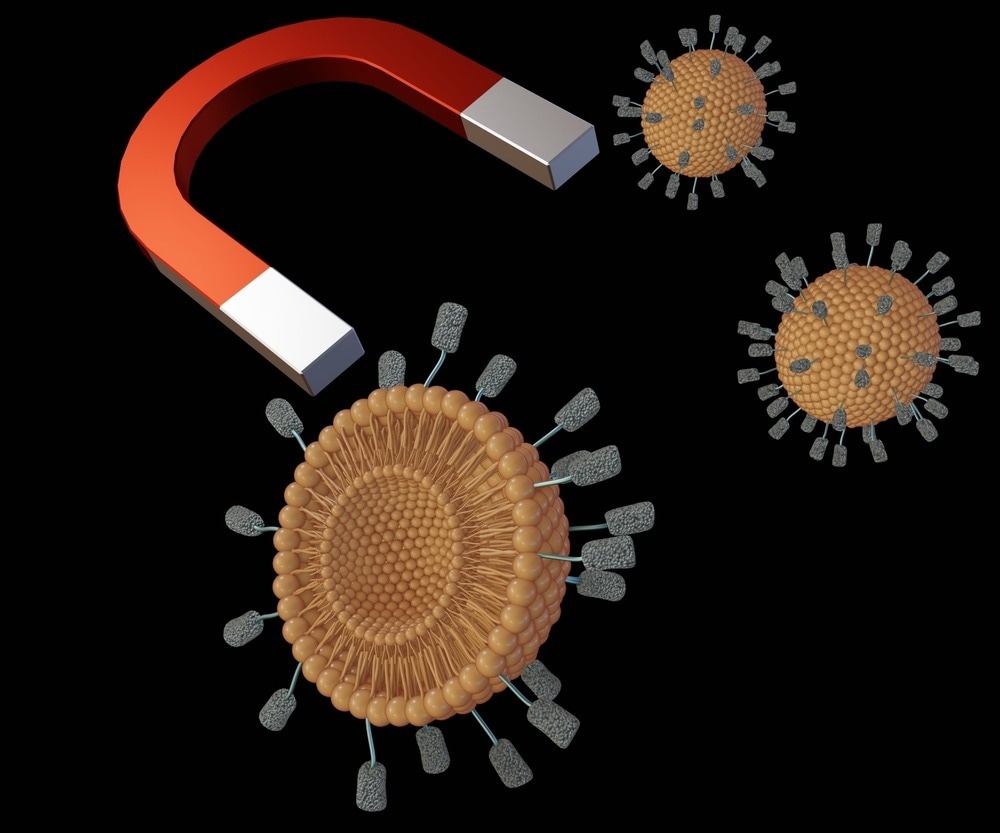Across the field of nanotechnology, diverse nanomaterials are being utilized to kickstart innovation in a range of applications, including energy storage, medicine and environmental remediation. In this article, AZoNano covers one nanomaterial in particular: magnetic nanoparticles.

Image Credit: Love Employee/Shutterstock.com
Magnetic Nanoparticles: An Introduction
In the early 1990s, significant advancements in materials science and nanotechnology allowed scientists to synthesize and characterize nanoparticles with unprecedented precision. Magnetic nanoparticles, specifically, gained importance due to their unique properties and potential applications. Magnetic nanoparticles, generally made from magnetic elements or compounds such as iron, cobalt, nickel, or their alloys, exhibited exceptional magnetism at the nanoscale. Magnetic nanoparticles could be controlled by applying external magnetic fields and exhibited superparamagnetism.2
Physical Properties of Magnetic Nanoparticles
Magnetic nanoparticles exhibit a range of physical properties due to their small size and unique structure. Understanding and harnessing the physical properties of magnetic nanoparticles is essential for utilizing them in diverse fields, including medicine, electronics, environmental remediation, and energy. By manipulating these properties, researchers can design and optimize magnetic nanoparticles for specific applications, leading to advancements in various technological domains.
Some of the highlight physical properties of magnetic nanoparticles include:
Magnetism
Magnetic nanoparticles possess magnetic properties, allowing them to respond to external magnetic fields. Magnetic nanoparticles exhibit superparamagnetism, retaining their magnetization even after the external field is removed. This property makes magnetic nanoparticles highly useful in various applications, such as magnetic storage, biomedical imaging, and targeted drug delivery.
Size-Dependent Behaviour
The physical properties of magnetic nanoparticles are strongly influenced by their size. As the particle size decreases to the nanoscale, quantum effects become more prominent, leading to distinct phenomena like size-dependent magnetic behavior and enhanced surface-to-volume ratio.
Thermal Behaviour
Magnetic nanoparticles exhibit unique thermal properties, such as high magnetic heating efficiency under an alternating magnetic field. This property is exploited in magnetic hyperthermia therapy, where magnetic nanoparticles generate localized heat to target and destroy cancer cells. The thermal conductivity and heat dissipation of magnetic nanoparticles also impacts their performance in various applications, including thermal management and energy conversion.1
How Are Magnetic Nanoparticles Synthesised?
Magnetic nanoparticles can be synthesized using various methods, each offering unique advantages and control over particle size, shape, and composition. Some commonly used synthesis approaches for magnetic nanoparticles are discussed below.
Chemical Precipitation
Chemical precipitation involves the controlled precipitation of metal salts in the presence of reducing agents and surfactants. The reduction process converts metal ions into nanoparticles. For example, iron oxide nanoparticles can be synthesized by precipitating iron salts in alkaline conditions. This technique allows for precise control over particle size and composition.
Thermal Decomposition
Thermal decomposition is a widely used method for synthesizing magnetic nanoparticles. Metal-organic precursors are heated to high temperatures, causing them to decompose and form magnetic nanoparticles through nucleation. By carefully controlling the reaction conditions, such as temperature and reaction time, researchers can achieve the desired particle size and shape. This approach is particularly suitable for producing magnetic nanoparticles like iron, cobalt, or nickel.
Sol-Gel Method
The sol-gel method involves the hydrolysis and condensation of metal alkoxides to form a colloidal suspension (sol), which is then aged, dried, and calcined to obtain magnetic nanoparticles; making it suitable for synthesizing magnetic oxide nanoparticles like iron oxide, cobalt oxide, and manganese oxide.
Co-Precipitation
Co-precipitation involves simultaneously precipitating two or more metal salts to form mixed-metal nanoparticles. This method allows for incorporating different metal ions into the nanoparticle structure, leading to the synthesis of composite magnetic nanoparticles with tailored magnetic properties.3
Magnetic Nanoparticles: Commercial Landscape
The commercial landscape of magnetic nanoparticles has evolved over the past few decades, with an array of industries adopting their use.
In healthcare applications, magnetic nanoparticles have gained attention for their potential in targeted drug delivery, magnetic hyperthermia for cancer treatment, and magnetic resonance imaging (MRI) contrast agents. Their unique properties, such as high surface area and magnetic responsiveness, enable precise drug targeting and enhanced imaging capabilities.4
Within the realm of electronics, magnetic nanoparticles have shown particular applicability in data storage, magnetic sensors, and magnetic random-access memory (MRAM) devices. The properties of magnetic nanoparticles, coupled with their nanoscale size, render them indispensable in the pursuit of high-density data storage and magnetic field sensing.1
Furthermore, magnetic nanoparticles find applications in environmental remediation, wastewater treatment, and pollutant removal. Their magnetic nature allows for easy separation and recovery, making these magnetic nanoparticles effective for removing heavy metals and organic pollutants from contaminated water sources.5
As the demand for advanced technologies and sustainable solutions continues to rise, the commercial prospects for magnetic nanoparticles are expected to grow further. Ongoing research and development efforts aim to enhance their properties, improve synthesis methods, and explore new applications, paving the way for the widespread adoption of these nanoparticles in various industrial sectors.
Continue reading: Medical Applications of Magnetic Nanoparticles
References and Further Readings
Vatta, L. L., Sanderson, R. D., Koch, K. R. (2006) Magnetic Nanoparticles: Properties and Potential Applications. Pure Applied Chemistry, 78 (9), pp. 1793–1801. doi.org/10.1351/pac200678091793.
Ali, A., Shah, T., Ullah, R., Zhou, P., Guo, M., Ovais, M., Tan, Z., Rui, Y. K. (2021) Review on Recent Progress in Magnetic Nanoparticles: Synthesis, Characterization, and Diverse Applications. Frontiers in Chemistry, 9 (July), pp. 1–25. doi.org/10.3389/fchem.2021.629054.
Katz, E. (2019) Synthesis, Properties and Applications of Magnetic Nanoparticles and Nanowires—a Brief Introduction. Magnetochemistry, 5 (4). doi.org/10.3390/magnetochemistry5040061.
Akbarzadeh, A., Samiei, M., Davaran, S. (2012) Magnetic Nanoparticles: Preparation, Physical Properties, and Applications in Biomedicine. Nanoscale Research Letters, 7 (1), p. 144. doi.org/10.1186/1556-276X-7-144.
Patel, P., Nandi, A., Jha, E., Sinha, A., Mohanty, S., Panda, P. K., Mishra, S., Verma, S. K., Suar, M. 2. (2021) Magnetic Nanoparticles: Fabrication, Characterization, Properties, and Application for Environment Sustainability, Woodhead Publishing, pp. 33-64. doi.org/10.1016/B978-0-12-823688-8.00017-X.
Disclaimer: The views expressed here are those of the author expressed in their private capacity and do not necessarily represent the views of AZoM.com Limited T/A AZoNetwork the owner and operator of this website. This disclaimer forms part of the Terms and conditions of use of this website.